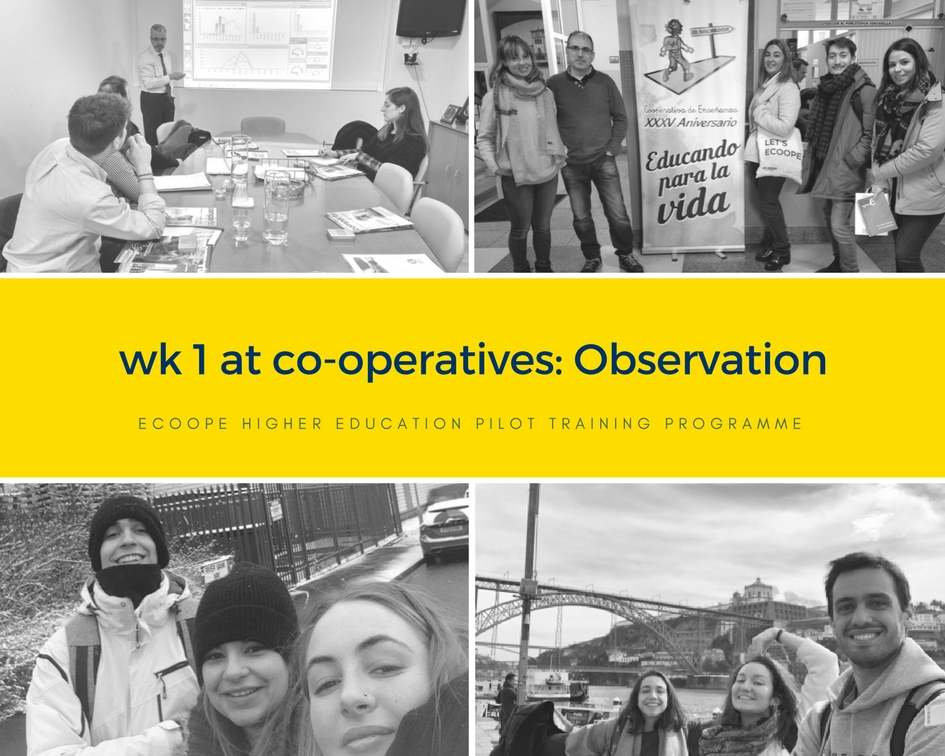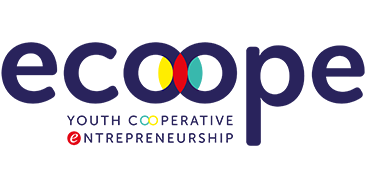
16 Mar Week 1 at Co-operatives: Observation
«I have learned to think “H2H”, human to human: to take my time when talking with people and stakeholders. This is key to open the door towards new knowledge and a better, more empathetic business».- Samuele Verucchi
Our participants in the ECOOPE pilots, all from very different backgrounds, have spent their first week at coops observing and compiling as much information as possible in order to get the overall picture of the companies’ situation: where they are, how they work, the challenges they face and their future goals.
The challenges the coops would like our «eco-opers» to solve in the weeks ahead are varied, since, as we mentioned in our previous post, the participating cooperatives belong to different sectors:
- Adega Cooperativa de Mesao Frio (Portugal) – winery
- El Salvador in Torrelavega (Cantabria, Spain) – cooperative school
- Fundación Espriu (Grupo HLA) – healthcare
- SUMA Wholefoods (West Yorkshire, England) – organic and fairtrade
The knowledge acquired by the participants during the preparatory course at CISE is proving crucial: whenever we are faced with «wicked» problems, we need to make use of critical and design thinking methodologies so that we are not «attracted» to the first, easy solution that comes to our mind. We actually need to go further and explore in order to find out what the actual cause/s of the problem is/are, and this in turn will surely help us identify all possible combinations and the best solutions, taking the context into account.
Our teams have been studying things like the companies’ organisation and human capital, their facilities and resources, their production capacity, the stakeholders map and relationships among them, etc.
For Adega Cooperativa de Mesao Frio, the challenge was putting in place an internationalisation plan addressed to the Spanish market. Our students have identified two sub-challenges: one dealing with the need for a new communication strategy (website and social media channels, that better feature their internationalisation strategy) and another one, building a structured contact database of wine lovers, mavens, university professors, and companies related to wine. Making use of interviews and the study of the last financial report and accounts, they have been able to validate the challenge. They will be using tools such as TeamGannt, Canva, SEO Quake, MindMeister, Google apps…
For El Salvador School the challenge was attracting the same or even a higher number of students each year, even with decreasing birth rates. Our team in Cantabria has confirmed the downward tendency of birth rates in the region and, through personal interviews to parents, teachers and management, have realised the birth rate tendency is only a part of the challenge: the school differentiates itself through their excellent educative programme (they strongly focus on innovation, the co-operative working style and the development of emotional intelligence, always putting the student at the centre), however they lack the techniques to communicate their value proposition to its potential clients.
For Fundación Espriu the challenge was acquiring technological solutions to add extra value to their customer experience. The team has met with the Director, read journals, studied the website, their internal system, and observed through tours around the hospital. They have identified two customer segments, and done a research about the most common hospital apps. Also thanks to a recent marketing survey, they found out that what patients most look for when talking about healthcare apps is: access to their medical record, appointment arrangement and prescriptions (refills, medication reminders…). By using tools such as the Business Model Canvas, structured interviews and disjunctive questions they have been able to prepare their working plan for week 2.
As for SUMA, our eco-opers had to pivot and look for a challenge different from the one initially posed (improvement of internal communication system), since once there and with first-hand information, they realised it was too complex to be implemented in four weeks’ time. This is actually an example of what entrepreneurs have to deal with everyday: hypothesis/expectations – dynamic research – change of direction – validation – review and improvement… and the cycle goes on.
Nadja Planötscher says: «The hardest part is getting started: the first week we gathered a lot of information in order to understand how the co-operative works, what the challenge is really about and which are the expectations of the users. The first step was very important and required a lot of time and effort».
Real observation is more easily said than done.
Stay tuned for the evolution of the challenges!



No Comments